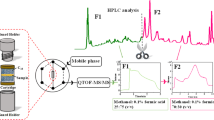Abstract
Potatoes produce biologically active secondary metabolites like glycoalkaloids and their aglycons, which may have both adverse and beneficial effects in the diet. A new analytical method that uses liquid chromatography–mass spectrometry (LTQ-Orbitrap) has been developed for the analysis of glycoalkaloids and their aglycons in potato samples. Two glycoalkaloids, α-solanine and α-chaconine, and two aglycons, demissidine and solasodine, were quantified in potato samples. Samples were extracted using methanol, purified on an SPE Strata C18 cartridge, and then analyzed in HPLC–mass spectrometry (LTQ-Orbitrap) with the FTMS operating in full scan at a resolving power of 30,000 (FWHM), enabling the detection and accurate mass measurement and with the ITMS mode operating in MRM (multiple reaction monitoring) for glycoalkaloids and their aglycons using the [M + H]+ ions and their optimized collision energies. After validation, the method was applied to screen different type of potatoes, and some cooking experiment were conducted.
Similar content being viewed by others
Abbreviations
- LIT:
-
Linear ion trap
- SPE:
-
Solid phase extraction
- ESI:
-
Electrospray ionization
- HESI:
-
Heated electrospray ionization
- FWHM:
-
Full width at half maximum
- FTMS:
-
Fourier transform mass spectrometry
- CE:
-
Collision energies
References
Chuda Y, Tsuda S, Ohara-Takada A, Kobayashi A, Suzuki K, Ono H, Yoshida M, Nagata T, Kobayashi S, Mori M (2004) Quantification of light-induced glycoalkaloids, α-solanine and α-chaconine, in four potato cultivars (Solanum tuberosum L.) distributed in Japan by LC/MS. Food Sci Technol Res 10:341
Courtney L, Dinkins P, Peterson RKD (2008) A human dietary risk assessment associated with glycoalkaloid responses of potato to Colorado potato beetle defoliation. Food Chem Toxicol 46:2837
Duke JA (1992) Handbook of biologically active phytochemicals and their activities. CRC Press, Boca Raton
Friedman M (2004) Analysis of biologically active compounds in potatoes (Solanum tuberosum), tomatoes (Lycopersicon esculentum), and jimson weed (Datura stramonium) seeds. J Chromatogr A 1054:143
Friedman M, Dao L (1992) Distribution of glycoalkaloids in potato plants and commercial potato products. J Agric Food Chem 40:419
Friedman M, McDonald GM (1997) Potato glycoalkaloids: chemistry, analysis, safety, and plant physiology. Crit Rev Plant Sci USA 16(1):55–132
Friedman M, Henika PR, Mackey BE (2003a) Effect of feeding solanidine, solasodine and tomatidine to non-pregnant and pregnant mice. Food Chem Toxicol 41:61
Friedman M, Roitman JN, Kozukue N (2003b) Glycoalkaloids and callystegine contents of eight potato cultivars. J Agric Food Chem 51:2964
Hogenboom AC, van Leerdam JA, de Voogt P (2009) Accurate mass screening and identification of emerging contaminants in environmental samples by liquid chromatography–hybrid linear ion trap Orbitrap mass spectrometry. J Chromatogr A 1216:510
Horwitz W (2000) Official methods of analysis of AOAC International, vol. 2, 17th edn. AOAC International, USA, p 62
Jadhav SJ, Salunkhe DK (1974) Effects of certain chemicals on photoinduction of chlorophyll and glycoalkaloid synthesis and on sprouting of potato tubers. Can Inst Food Sci Technol J 7:178
Jadhav SJ, Salunkhe DK (1975) Formation and control of chlorophyll and glycoalkaloids in tubers of Solanum tuberosum and evaluation of glycoalkaloid toxicity. Adv Food Res 21:307
Jadhav SJ, Salunkhe DK, Wyse RE, Dalvi RR (1973) Solanum alkaloids. Bjosynthesis and inhibition by chemicals. J Food Sci 38:453
Lachman J, Hamouz K, Orsák M, Pivec V (2001) Potato glycoalkaloids and their significance in plant protection and human nutrition. Ser Rostlinná Výroba 47:181
Machado RMD, Toledo MCF, Garcia LC (2007) Effect of light and temperature on the formation of glycoalkaloids in potato tubers. Food Control 18:503
Matsuda F, Morino K, Miyazawa H, Miyashita M, Miyagawa H (2004) Determination of potato glycoalkaloids using high-pressure liquid chromatography-electrospray ionisation/mass spectrometry. Phytochem Anal 15:121
Morris SC, Lee TH (1984) The toxicity and teratogenicity of Solanaceae glycoalkaloids, particularly those of the potato (Solanum tuberosum). Food Technol Aust 36(3):118–124
Schreiber K (1966) Biochemistry of steroidal alkaloids. Abh Dtsch Akad Wiss Berlin KI Chem Geol Biol 3:65
Sotelo A, Serrano B (2000) High performance–liquid chromatographic determination of the glycoalkaloids α-solanine and α-chaconine in 12 commercial varietiesof Mexican potato. J Agric Food Chem 48:2472
Stobiecki M, Matysiak-Kata W, Franski R, Skala J, Szopa J (2003) Monitoring changes in anthocyanin and steroid alkaloid glycoside content in lines of transgenic potato plants using liquid chromatography/mass spectrometry. Phytochem 62:959
Tahboub YR, Zaater F, Al-Talla ZA (2005) Determination of the limits of identification and quantitation of selected organochlorine and organophosphorous pesticide residues in surface water by full-scan gas chromatography/mass spectrometry. J Chromatogr A 1098:150
Tajner-Czopek A, Jarych-Szyszka M, Lisinska G (2008) Changes in glycoalkaloids content of potatoes destined for consumption. Food Chem 106:706
Uppal DS (1987) Varietal and environmental effect on the glycoalkaloid content of potato (Solanum tuberosum L.). Plant Foods Hum Nutr 37:333
Vaananen D, Ikonen T, Rokka VM, Kuronen P, Serimaa R, Ollilainen V (2005) Influence of incorporated wild Solanum genomes on potato properties in terms of starch nanostructure and glycoalkaloid content. J Agric Food Chem 53:5313
Zywicki B, Catchpole G, Draper J, Fiehn O (2005) Comparison of rapid liquid chromatography-electrospray ionization-tandem mass spectrometry methods for determination of glycoalkaloids in transgenic Weld-grown potatoes. Anal Biochem 336:178
Conflict of Interest
Giovanni Caprioli declares that he has no conflict of interest. Michael G. Cahill declares that he has no conflict of interest. Kevin J. James declares that he has no conflict of interest. Sauro Vittori declares that he has no conflict of interest. This article does not contain any studies with human or animal subjects.
Author information
Authors and Affiliations
Corresponding author
Rights and permissions
About this article
Cite this article
Caprioli, G., Cahill, M.G., Vittori, S. et al. Liquid Chromatography–Hybrid Linear Ion Trap–High-Resolution Mass Spectrometry (LTQ-Orbitrap) Method for the Determination of Glycoalkaloids and Their Aglycons in Potato Samples. Food Anal. Methods 7, 1367–1372 (2014). https://doi.org/10.1007/s12161-013-9758-6
Received:
Accepted:
Published:
Issue Date:
DOI: https://doi.org/10.1007/s12161-013-9758-6




